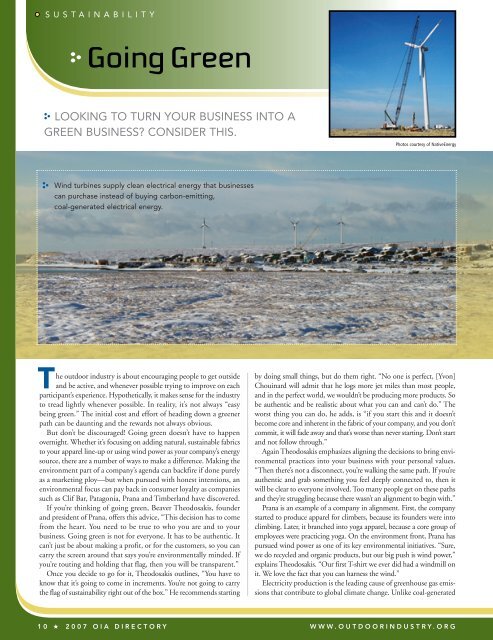Member Resource Guide - Outdoor Industry Association
Member Resource Guide - Outdoor Industry Association
Member Resource Guide - Outdoor Industry Association
You also want an ePaper? Increase the reach of your titles
YUMPU automatically turns print PDFs into web optimized ePapers that Google loves.
SUSTAINABILITY<br />
Going Green<br />
LOOKING TO TURN YOUR BUSINESS INTO A<br />
GREEN BUSINESS? CONSIDER THIS.<br />
T<br />
Wind turbines supply clean electrical energy that businesses<br />
can purchase instead of buying carbon-emitting,<br />
coal-generated electrical energy.<br />
he outdoor industry is about encouraging people to get outside<br />
and be active, and whenever possible trying to improve on each<br />
participant’s experience. Hypothetically, it makes sense for the industry<br />
to tread lightly whenever possible. In reality, it’s not always “easy<br />
being green.” The initial cost and effort of heading down a greener<br />
path can be daunting and the rewards not always obvious.<br />
But don’t be discouraged! Going green doesn’t have to happen<br />
overnight. Whether it’s focusing on adding natural, sustainable fabrics<br />
to your apparel line-up or using wind power as your company’s energy<br />
source, there are a number of ways to make a difference. Making the<br />
environment part of a company’s agenda can backfire if done purely<br />
as a marketing ploy—but when pursued with honest intentions, an<br />
environmental focus can pay back in consumer loyalty as companies<br />
such as Clif Bar, Patagonia, Prana and Timberland have discovered.<br />
If you’re thinking of going green, Beaver Theodosakis, founder<br />
and president of Prana, offers this advice, “This decision has to come<br />
from the heart. You need to be true to who you are and to your<br />
business. Going green is not for everyone. It has to be authentic. It<br />
can’t just be about making a profit, or for the customers, so you can<br />
carry the screen around that says you’re environmentally minded. If<br />
you’re touting and holding that flag, then you will be transparent.”<br />
Once you decide to go for it, Theodosakis outlines, “You have to<br />
know that it’s going to come in increments. You’re not going to carry<br />
the flag of sustainability right out of the box.” He recommends starting<br />
10 ★ 2007 OIA DIRECTORY<br />
Photos courtesy of NativeEnergy<br />
by doing small things, but do them right. “No one is perfect, [Yvon]<br />
Chouinard will admit that he logs more jet miles than most people,<br />
and in the perfect world, we wouldn’t be producing more products. So<br />
be authentic and be realistic about what you can and can’t do.” The<br />
worst thing you can do, he adds, is “if you start this and it doesn’t<br />
become core and inherent in the fabric of your company, and you don’t<br />
commit, it will fade away and that’s worse than never starting. Don’t start<br />
and not follow through.”<br />
Again Theodosakis emphasizes aligning the decisions to bring environmental<br />
practices into your business with your personal values.<br />
“Then there’s not a disconnect, you’re walking the same path. If you’re<br />
authentic and grab something you feel deeply connected to, then it<br />
will be clear to everyone involved. Too many people get on these paths<br />
and they’re struggling because there wasn’t an alignment to begin with.”<br />
Prana is an example of a company in alignment. First, the company<br />
started to produce apparel for climbers, because its founders were into<br />
climbing. Later, it branched into yoga apparel, because a core group of<br />
employees were practicing yoga. On the environment front, Prana has<br />
pursued wind power as one of its key environmental initiatives. “Sure,<br />
we do recycled and organic products, but our big push is wind power,”<br />
explains Theodosakis. “Our first T-shirt we ever did had a windmill on<br />
it. We love the fact that you can harness the wind.”<br />
Electricity production is the leading cause of greenhouse gas emissions<br />
that contribute to global climate change. Unlike coal-generated<br />
WWW.OUTDOORINDUSTRY.ORG


